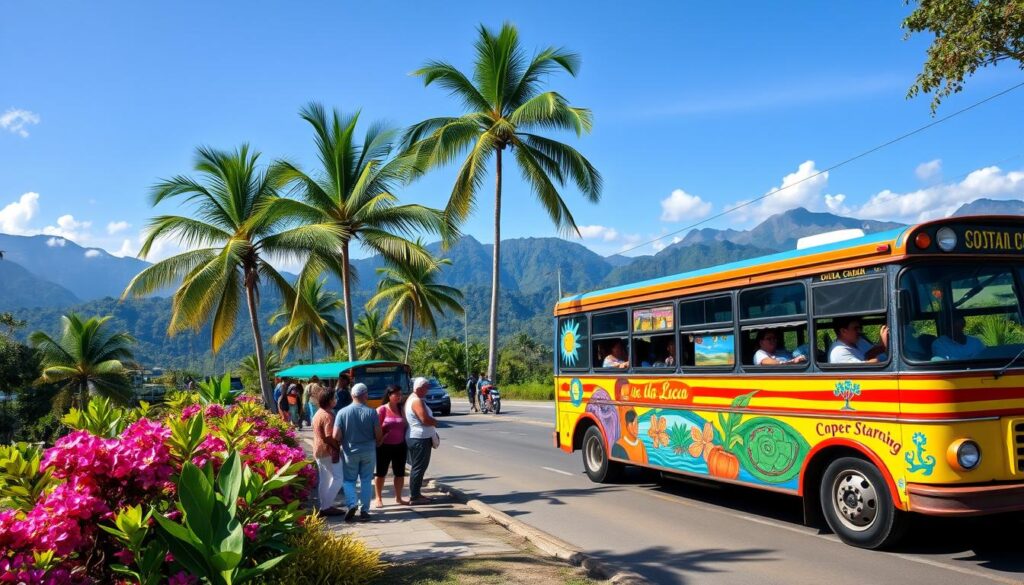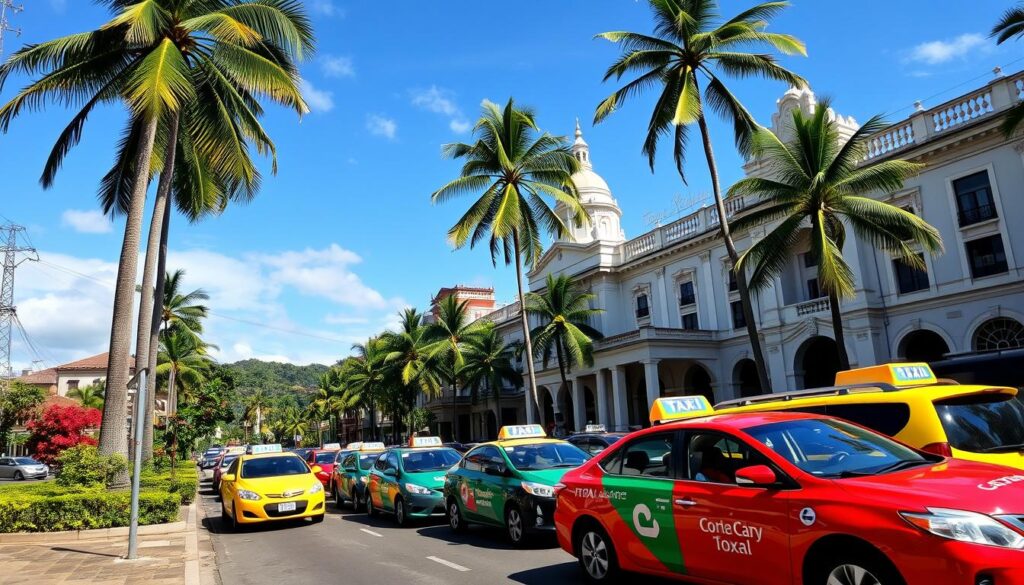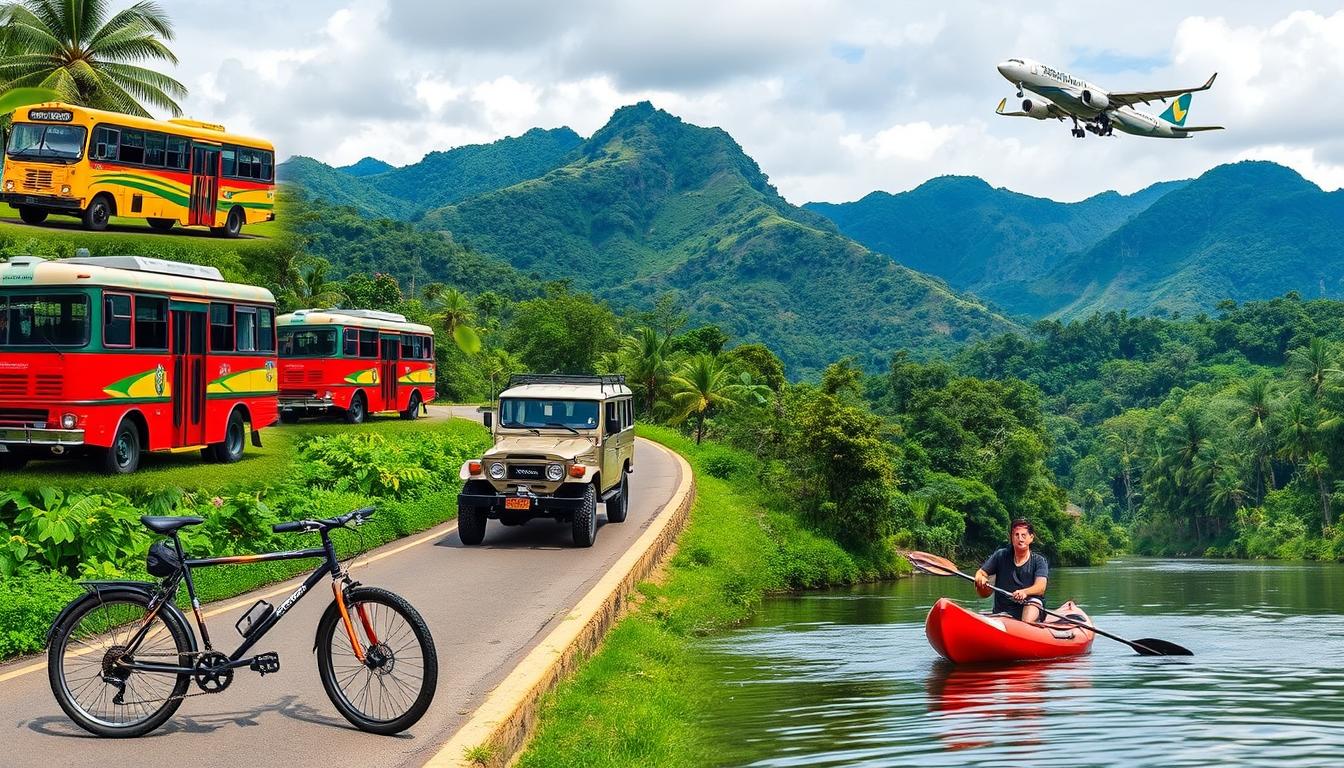Are you ready for an adventure in Costa Rica? Knowing the best ways to get around is important. This place has many ways to see its beauty, like mountain roads and coastal highways. Costa Rica has something for everyone, from cheap to luxury travel.
Traveling in Costa Rica is an adventure. Affordable buses connect big places. Tourist shuttles are faster but cost more. Renting a car lets you explore far-off spots. Boats and flights give you special views of the country.
Knowing how to travel in Costa Rica is key. From planning your trip to picking how to get there, every choice matters. Let’s explore how to make your trip smooth and fun.
Key Takeaways
- Costa Rica offers varied transport options for different budgets
- Renting a car provides flexibility for exploring remote areas
- Public buses are affordable but may have limited schedules
- Domestic flights save time for covering longer distances
- Boat services offer scenic routes to coastal destinations
- Planning ahead is crucial for efficient travel within Costa Rica
Understanding Costa Rica’s Transportation Landscape
Costa Rica has different landscapes and geography. Travelers need to know the main places and when to go. This helps plan trips well.
Geography and Major Transportation Hubs
Costa Rica has coastlines and mountains. San José is the main place for travel. Liberia and Limón are also important.
Peak vs. Off-Peak Travel Seasons
Travel in Costa Rica changes with the seasons. The dry season is busier. The green season is less crowded and cheaper
Transportation Infrastructure Overview
Costa Rica has roads, airports, and seaports. Main roads are good, but rural areas can be tough. Renting a 4×4 is wise for remote places.
| Transportation Type | Coverage | Reliability |
|---|---|---|
| Buses | Extensive | Good |
| Domestic Flights | Limited | Excellent |
| Ferries | Coastal Areas | Moderate |
Knowing Costa Rica’s transport is key for a smooth trip. Think about your trip, budget, and what you like when picking transport. With good planning, traveling here is fun.
Renting a Car in Costa Rica
Driving a car in Costa Rica is very free and easy. You can see many places and find hidden spots. First, learn about renting and driving in Costa Rica.
Required Documents and Insurance
You need a valid driver’s license and a credit card for the deposit to rent a car. Some places might ask for an international driving permit. You must have insurance, which covers basic things. You can buy more for extra safety.
Best Rental Companies
Many good companies offer cars for rent in Costa Rica. Here’s a look at some top ones:
| Company | Vehicle Types | Price Range | Customer Rating |
|---|---|---|---|
| Adobe Rent a Car | Economy to Luxury | $30-$100/day | 4.5/5 |
| Vamos Rent-A-Car | Compact to 4×4 | $35-$90/day | 4.7/5 |
| Alamo | Economy to SUV | $40-$120/day | 4.3/5 |
4×4 vs. Regular Vehicle Considerations
Choosing the right car depends on where you’re going. For cities and good roads, a regular car is fine. But for rural areas or rainy times, a 4×4 is better. It helps with rough roads and crossing rivers.
Gas Stations and Fuel Tips
Gas stations in Costa Rica are full-service and take cash and cards. Fuel prices are the same everywhere. Plan your trip well, as gas stations are far in the countryside. Always keep your tank half full for a safe trip.
Navigating Costa Rica’s Public Bus System
Costa Rican public transportation is cheap and easy. It connects big cities, towns, and places tourists like to visit.

Most of the country is covered by bus routes. You can easily get to places like Manuel Antonio, Arenal, and Monteverde. Tickets cost between $1 and $20, based on how far you’re going.
To use the bus system well:
- Check schedules at local terminals or online
- Arrive early to get a seat
- Have small bills ready for fare
- Keep valuables safe during the trip
Buses are reliable but can be full during busy times. Traveling during less busy hours is better. Some long trips have air-conditioned buses with comfy seats.
“The bus system in Costa Rica is a great way to experience local culture and see the countryside,” says Maria Gonzalez, a frequent traveler.
For budget travel in Costa Rica, the public bus is perfect. It lets you meet locals and see beautiful views.
Domestic Flights and Airlines
Costa Rica’s domestic flights are a quick way to see the country. They are great for those with little time or big travel plans. Let’s look at flying within this beautiful Central American nation.
Major Airlines and Routes
Two big airlines fly within Costa Rica: Sansa and Skyway. They go to places like San José, Liberia, Tamarindo, and Drake Bay. These airlines help you get to far-off spots fast.
| Airline | Popular Routes | Frequency |
|---|---|---|
| Sansa | San José to Quepos, Tamarindo, Liberia | Daily |
| Skyway | San José to Drake Bay, Puerto Jiménez, Tortuguero | 3-5 times weekly |
Booking Tips and Price Ranges
Book your flights early for the best prices. Prices are from $50 to $150 one-way. Look for deals, like those in the green season (May to November).
Airport Transfer Services
Most airports in Costa Rica have good transfer services. You can find taxis, shuttles, and car rentals at arrival areas. Pre-booking your transfer helps, for places far away.
“Flying domestically in Costa Rica opened up a world of possibilities for our trip. We saw so much more in less time!” – Sarah, Travel Blogger
Knowing about domestic flights helps you plan better trips. You can see more of Costa Rica’s beauty in less time.
Private Shuttle Services and Transfers
Private shuttle services make traveling in Costa Rica easy. They suit everyone, from solo travelers to big groups. Think about private transfers for a better trip when planning your tour.
Shared vs. Private Shuttle Options
Shared shuttles are good for those watching their budget. They run on set times and pick up people from different spots. Private shuttles give you more freedom and comfort, letting you choose your travel time and path.
| Feature | Shared Shuttle | Private Shuttle |
|---|---|---|
| Cost | Lower | Higher |
| Flexibility | Fixed schedule | Customizable |
| Privacy | Shared with others | Exclusive use |
| Comfort | Standard | Enhanced |
Popular Routes and Operators
Many shuttles go to top tourist spots. San José to Manuel Antonio and Liberia to Tamarindo are favorites. Companies like Interbus and Gray Line Costa Rica are known for their good service and safety.
Booking and Pricing Guidelines
Book your shuttle early, mainly in busy times. Prices change based on how far you’re going and the service type. For travel tips, look at prices from different places. Some give discounts for round trips or groups. Always check your pick-up times and places before you go.
Booking a private shuttle gave us the flexibility to stop at scenic spots along the way. It was worth the extra cost for a more personalized experience.
Think about your plans and money when picking between shared and private. Both are safe and comfy ways to see Costa Rica’s beautiful places.
Taxi and Ride-Sharing Services
Exploring costa rica transportation options? Taxis and ride-sharing are great choices. Official taxis in Costa Rica are red with a yellow triangle. In tourist spots, you’ll see orange taxis that cost more.

Ride-sharing apps like Uber are also available in big cities. They offer good prices and drivers who speak English. This makes them a favorite among tourists.
Here’s a quick comparison of taxi and ride-sharing options:
| Service | Availability | Pricing | Convenience |
|---|---|---|---|
| Official Taxis | Nationwide | Metered | Easy to hail on streets |
| Tourist Taxis | Popular destinations | Higher rates | Often at hotels/airports |
| Ride-sharing | Major cities | App-based pricing | Cashless transactions |
Stay safe by using official services and avoiding unmarked taxis. Always check driver details before you start your ride. These tips will make your transportation smooth during your visit.
Water Transportation Options
Exploring Costa Rica? Don’t miss the water transport options. Guides often talk about these ways to see the coastlines and islands.
Ferry Services
Ferry services are scenic and cheap. The Puntarenas-Paquera ferry links the mainland to the Nicoya Peninsula. It’s a key part of many trips, offering views and travel.
Boat Tours and Water Taxis
Boat tours and water taxis are great for the coast and beaches. In places like Manuel Antonio and Tortuguero, they’re key. They take you to spots hard to reach by road, adding adventure.
Island Transportation
For island hopping, small boats and ferries are best. Isla del Coco, known for diving, is reached by boat from Puntarenas. The trip is 36 hours, perfect for the bold.
| Water Transport | Best For | Travel Time |
|---|---|---|
| Ferry | Nicoya Peninsula | 70 minutes |
| Water Taxi | Coastal Exploration | Varies |
| Boat Tour | Wildlife Watching | 2-4 hours |
Water transport in Costa Rica is more than travel. It’s a chance to see the country’s beauty and wildlife. You might see dolphins or sea turtles, making the trip exciting.
Safety Tips for Different Transportation Methods
Exploring Costa Rica means keeping safety first. This guide gives you key tips for a safe trip. You’ll learn how to stay safe in different ways to travel.
Road Safety Guidelines
Driving in Costa Rica needs extra care. Roads can be tough, mainly in rural spots. Always wear seatbelts and try to avoid driving at night.
Keep your valuables hidden and lock your car. If you rent a car, pick a good company. Check the car before you leave.
Public Transportation Safety
Public buses are cheap and popular. Stick to known bus companies and keep your stuff close. For taxis, use red cabs or apps.
Avoid unmarked taxis to avoid scams. When on ferries, listen to the crew and find life jackets.
Night Travel Considerations
Try to avoid traveling at night. If you must, use private shuttles or trusted taxis. Be careful in bus stations at night.
Book your place to stay early to avoid looking for it at night. These tips will make your trip safer and smoother.
“Safety doesn’t happen by accident. Plan ahead and stay vigilant to make the most of your Costa Rican adventure.”
Follow these tips to travel safely in Costa Rica. You’ll enjoy the country’s beauty and culture more.
Planning Multi-Destination Itineraries
Planning your trip to Costa Rica can be fun. Many people want to see different places. Tour packages often mix beach fun with rainforest adventures.
Popular Routes and Combinations
A common trip starts in San José. Then, it goes to Arenal Volcano and Manuel Antonio National Park. It ends in Tamarindo. This path gives you city life, volcanic views, wildlife, and beach time.
Another favorite is visiting Monteverde’s cloud forests and the Nicoya Peninsula’s beaches. It’s a mix of nature and relaxation.
Time Management Tips
Make sure to spend enough time in each place. Aim for at least two nights per spot. Also, remember travel times can be long due to roads and weather.
Transportation Booking Strategy
Book your main travel early, mainly in busy seasons. Rent a car for some parts and use shuttles or flights for long trips. This way, you can travel at your pace and skip tough roads.


